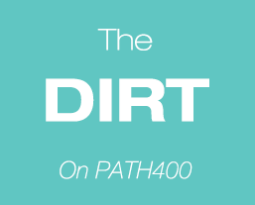What’s in the PATH400 Pond?
Stephanie Bilodeau, an aquatic biologist from Georgia Tech, tells us about her research.
Greetings from PATH400… or if you want to be really specific, greetings from the pond by the path!
If you’ve been out along the greenway, you may have seen me wading around the pond across from the heron mural, so I thought I’d tell you all what I’ve been working on here. I promise I didn’t fall in by accident—I’m actually doing research! As part of my PhD at Georgia Tech, I’ve been studying the freshwater plants and animals that live in the pond, and I wanted to share a couple details that you might not have seen from the path itself.

Parrotfeather
One of the first plants I noticed, and the one that got me interested in working at PATH400, is the fluffy green parrot feather milfoil that grows around the edges (and sometimes the middle) of the water. It’s actually from South America, and the thing that caught my attention is that during the winter, it’s one of the only green things in the pond. Parrot feather is pretty and also pretty invasive (yikes!), but the good news is that my research suggests this plant is pretty good food for native herbivores, too. Having a healthy ecosystem with a variety of plant eaters, from mammals and birds all the way down to tiny insects, can help keep plants like parrot feather from getting out of hand.
Duckweed
This time of year, there’s also another plant growing all over the pond, and you might not even realize it’s a plant at all. That pale green on the surface of the water isn’t pond scum (algae). It’s actually a native plant called duckweed! Up close, each teeny tiny duckweed plant has an oval leaf and roots that reach down into the water, and they often grow in clumps of three or four (or more). Duckweed is one of the smallest flowering plants in the world, although you probably won’t see the ones along PATH400 flowering because reproduction is faster if they just clone themselves! (Parrot feather does this, too.) Since most of you will not be wading around with the Canada geese, you’ll have to take my word for it that there are some really cool critters living in and around the floating mats of duckweed in the pond.


What’s this caterpillar doing in the water?
One of my favorite animals in the PATH400 pond are semi-aquatic caterpillars (genus Elophila). If you didn’t know that caterpillars could live in the water, don’t worry—neither did I until I found them there! These caterpillars don’t have gills, so they have to live at the surface of the water. They build these little cases or houses of plants around themselves (kind of like a hermit crab’s shell). So far, I’ve discovered that the cases can protect the caterpillars from ants and spiders, as well as from the Atlanta heat. A caterpillar will float with the duckweed and other aquatic plants, eating its tiny heart out, until it is time to turn into an adult moth. Then, the caterpillar grabs hold of a plant sticking out of the water (a stem of parrot feather, for example) and builds its cocoon inside its little plant house. A couple weeks later, it emerges as a tiny little moth about the size of your fingernail.
The next time you’re heading down PATH400, stop by the pond and take a look at the plants. Remember that the animals you don’t see help to determine the plants that you do. And if you happen to see me out wading in the water with my face three inches from a patch of duckweed, don’t worry about me. I’ve got caterpillars to find!
You can read more about Stephanie and her work at StephBilodeau.com




